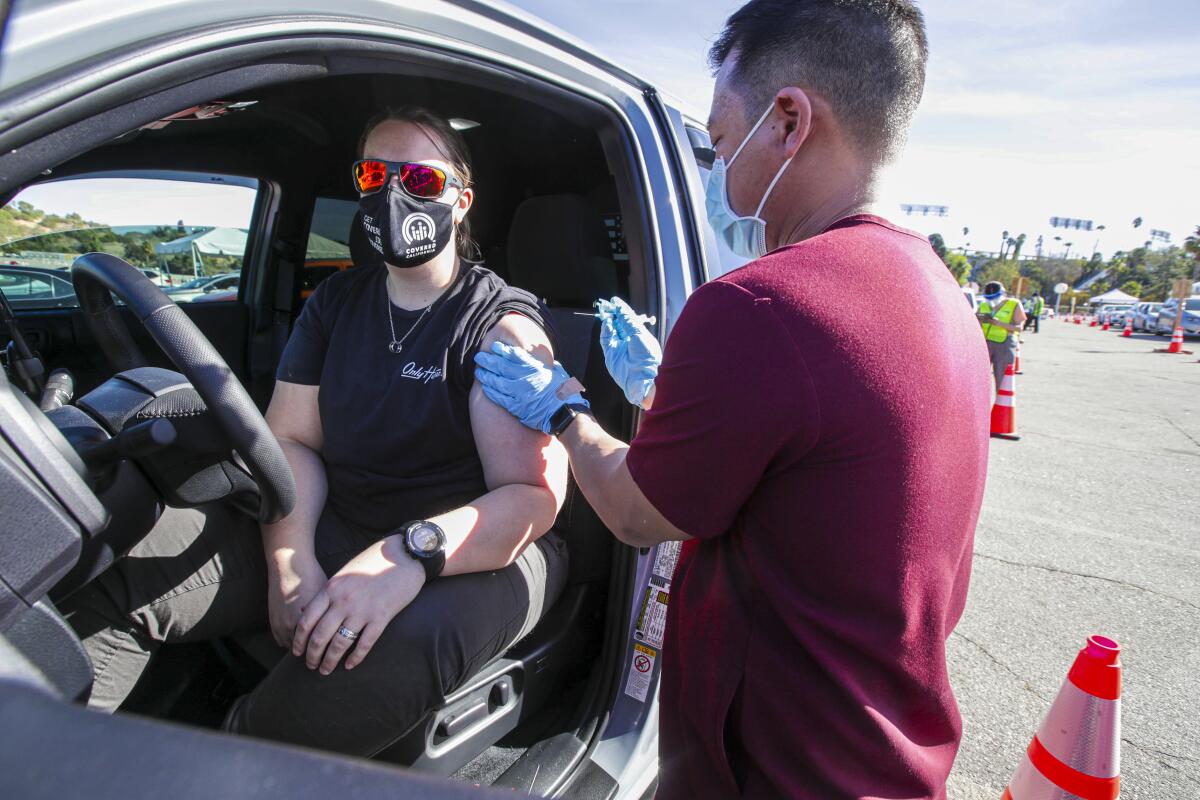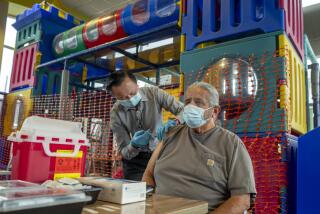L.A. County teachers, some essential workers eligible for vaccine starting Monday

- Share via
Teachers and workers in child care, emergency services and food and agriculture will be eligible to receive COVID-19 vaccinations in Los Angeles County starting Monday, though officials warn that the pace will be slowed by limited supply.
Nearly 1.2 million people fall into these newly approved categories, according to county estimates. They will join about 2.2 million L.A. County residents who are already eligible to be vaccinated — those who work in healthcare, live in long-term care facilities or are 65 or older.
“Opening eligibility to more groups of essential workers will save more lives and accelerate our recovery,” Los Angeles Mayor Eric Garcetti said Sunday in a statement.
The county has so far administered more than 2.1 million doses of vaccine (first and second doses), according to The Times’ vaccination tracker.
Newly eligible residents will be able to make appointments at city-run vaccination sites starting Monday, the mayor’s office said, but only a small number of first-dose appointments will be available this week, at Pierce College.
The 70,000 doses of Moderna vaccine the city expects to receive Monday will go primarily to its six mass vaccination sites, which are open Tuesday through Saturday, to be administered as second doses, Garcetti’s office said. Appointments for the second shot were being scheduled automatically for people who received their first dose at a city-run site between Feb. 1 and Feb. 6.
An additional 7,000 doses of the Pfizer vaccine that are expected Monday will be provided as first doses through the city’s mobile vaccination program, which aims to deliver inoculations directly to the hardest-hit neighborhoods, officials said.
The program is set to triple the number of doses administered this week, from 4,000 to 12,000, through clinics offering first doses in Baldwin Hills, South Park, Highland Park, Panorama City, Westlake and Pacoima and clinics offering second doses in Baldwin Hills, South Park and Vermont Vista, the city said.
Supply remains the chief barrier to doling out more vaccine, Garcetti’s office said, noting that last week the city administered more than 90,000 doses, a peak but still only 68% of the program’s capacity.
Like many states, California has distributed the vaccine in phases, setting broad criteria for who can be inoculated at each step. Exactly how that has played out has varied by city and county, with officials facing tough choices when it comes to determining who should be prioritized to receive a limited share of vaccine.
Long Beach, which has its own health department and receives its own vaccine supply, started vaccinating food workers and educators in January at sector-specific clinics. More than 3,000 restaurant workers, market employees, cooks and other food industry workers are slated to be vaccinated Friday at a clinic at the Long Beach Convention Center, the city said.
In San Francisco, workers in education, child care and food and agriculture were eligible to receive vaccinations starting Friday.
Orange County last week began earmarking doses for workers in education, child care, and food and agriculture, saying it would dedicate 30% of its allocation to workers in those sectors, as well as those in emergency services; the remaining 70% goes to residents 65 or older. Seniors and first responders who work in high-risk communities have been eligible to be vaccinated since mid-January.
San Bernardino County also expanded vaccinations to educators last week, and Ventura County said it would start vaccinating teachers, food and agriculture workers and emergency services workers.
San Luis Obispo County will start scheduling vaccinations for some local child-care workers and teachers starting Monday; they will be contacted by their employer for an appointment and should not try to schedule one themselves, the county said.
California and other states have seen political discord over vaccination priorities, and leaders have said such clashes are unavoidable.
Gov. Andy Beshear (D-Ky.) said his state was about to become the first to fully vaccinate all educators, but the process has been contentious at times. “We pushed our teachers to the front of the line, moving them up faster than the [Centers for Disease Control and Prevention] or other states had,” the governor said in an interview on CBS’ “Face the Nation.”
“Everything’s difficult in COVID, even the concept of what’s an essential worker — is one person more essential than another?”
Where educators are concerned, Beshear said, Kentucky was guided by science as well as social need.
“It was development for our children scholastically, emotionally and socially,” he said. “We made this call early on — we stuck to it.”
The expansions in eligibility come as public health authorities in California and across the country continue to report declines in new cases and hospitalizations.
The Los Angeles County Department of Public Health on Sunday recorded 1,064 new cases and 107 related deaths. There were 1,578 COVID-19 patients in county hospitals Saturday, a drop of nearly 50% from two weeks before.
Still, experts say it’s crucial to remain cautious.
President Biden’s chief medical advisor, Dr. Anthony Fauci, said Sunday that even with heartening news about the declining national caseload and the accelerating vaccine rollout, some states, including California, are a source of concern because of emerging coronavirus variants.
Appearing on “Face the Nation,” Fauci said “we will be” victorious in the fight against the virus, but “we’re not there yet, particularly with the variants that are circulating in various parts of the country, such as in California and New York.”
In California, these include the U.K. variant, which spreads more readily than its predecessors and may be more deadly, as well as a homegrown variant that may have the ability to evade antibodies generated by vaccines or prior infection.
The presence of the variants, combined with the sluggish pace of vaccinations due to supply constraints and fatigue over public health rules, have some expressing fears of a potential “fourth wave” of new cases.
That possibility has set off a race to vaccinate as many people as possible before a surge triggers another wave of disease and gives the variants more opportunities to mutate. Authorities hope to significantly speed up efforts with the arrival of a vaccine by Johnson & Johnson that requires only one dose, unlike the Pfizer and Moderna vaccines, and does not need to be stored at such cold temperatures.
The Johnson & Johnson vaccine was cleared Saturday by the Food and Drug Administration and recommended Sunday by a CDC committee. Senior officials from the Biden administration said they were excited to add a third authorized vaccine to the country’s arsenal.
“The bottom line here is we have a safe and highly efficacious vaccine,” said one official, who requested anonymity when discussing the administration’s plans.
Another official said nearly 4 million Johnson & Johnson doses would be distributed as soon as Tuesday.
However, that represents the company’s entire stockpile, and it could take time to ramp up production. An additional 16 million doses are expected to be shipped by the end of March. Delivery will be “uneven,” the official said, but “we’re getting doses out the door as quickly as possible.”
Fauci, appearing on CNN’s “State of the Union,” called the approval of the Johnson & Johnson vaccine “very good news.” If he were awaiting a shot, he said, “I would take whatever vaccine would be available to me as quickly as possible.”
The Johnson & Johnson approval means that “now we have three important tools” for combating the virus through vaccinations, Fauci added.
CDC Director Rochelle P. Walensky agreed, saying in a statement that the approval comes “at a potentially pivotal time.”
“CDC’s latest data suggest that recent declines in COVID-19 cases may be stalling and potentially leveling off at still very high numbers,” Walensky said. “That is why it is so critical that we remain vigilant and consistently take all of the mitigation steps we know work to stop the spread of COVID-19 while we work our way toward mass vaccination.”
More to Read
Sign up for Essential California
The most important California stories and recommendations in your inbox every morning.
You may occasionally receive promotional content from the Los Angeles Times.












